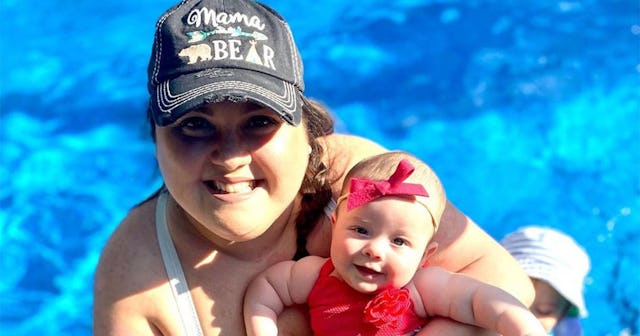Your Kids Can Drown Even If You Are Right There

When my oldest son was three and a half, and my second son was just a couple months old, our family spent an evening at the community pool. We had the whole place to ourselves. The baby happily napped in a bassinet poolside, and my husband and I splashed and played with our older son. He wore a swim vest, and paddled happily around the pool, even cautiously jumping into our arms from the side.
When the baby woke up, we decided to call it a night. We got out, took Henry’s vest off, and wrapped ourselves up in towels. Henry was sitting right next to me. My husband grabbed a chair for me to sit and feed the baby. We turned our backs for literally three to five seconds.
That’s all it took. While I was still getting the baby situated to eat, my husband let out a bone-chilling shout. Our obedient, sweet, cautious boy who had never, ever wandered away from us before had run into the pool and started down the steps, his 41-inch body stepping into four feet of water just as my husband turned to see him.
Scott got to him in a flash. In seconds, he was back in my arms, and we both cried as we realized he was okay. He said, “I never want to go under the water again!” It was one of the scariest moments of my life.
If we hadn’t seen him right away… I can’t let my mind finish the thought.
The experience has stuck with me. I have been even more cautious about water safety with my second child.
We mostly swim at my dad’s house now, and I don’t even let Walker into the yard without a swim vest on. He loves the water, and he is fearless, jumping in on his own, enjoying every moment.
Last week, Henry learned to swim without a vest. I guess Walker saw his big brother swimming like the grown-ups and thought he would give it a try, too.
My dad and I sat on the steps with my new baby. Walker was playing in the shallow end, maybe five feet away, making up a story with four rubber ducks. The baby splashed and giggled, and my father and I looked at her and away from Walker for just a few seconds.
I scanned the pool for my boys. Henry was exactly where he was last time I’d checked a few seconds earlier, but when I saw Walker, I let out a scream.
“Dad! Get him!”
Walker had swum to the edge and removed his own vest—something we had no idea he could do—and put it on the side of the pool. He was kicking wildly, trying to keep his head above the water, but he was failing. My baby was seconds from drowning, and I had an infant in my arms.
Thankfully, my father was able to rescue Walker in seconds. I handed the baby to my dad, and grabbed my son so tightly. As I sat at the edge of the pool and held him close, my mind raced back to that night four years ago when I felt the same terror and the same sweet relief.
I have been so, so lucky.
https://www.instagram.com/p/CBireivp9Ak/
Both of my kids have had close calls now, and I am not embarrassed to let you know.
Because I was sitting right there both times.
It took seconds both times.
I mean, one of the times my son was wearing a flotation device!
It just goes to show that there is no such thing as too careful when it comes to preschoolers and the water.
I am not a negligent parent. I didn’t make risky choices. My kids didn’t even sneak out an unlocked door or find their way into the water when we didn’t expect them to be swimming.
Both times my kids have found their way into water they couldn’t navigate alone, I was sitting right next to them. Both times, we were able to scoop them up right away and save them from disaster precisely because we were so close.
But they still found a way to do something unpredictable and put themselves at risk. It takes just a couple seconds for a child to make a choice they can’t fully understand, and find themselves in life-threatening danger.
According to the CDC, “Drowning is the second leading cause of injury death for children ages 1 to 14 years. In fact, more children 1-4 years die from drowning than any other cause of death except birth defects.”
I’ll say it again: When it comes to water safety, there is no such thing as too careful. Especially when you’re talking about toddlers and preschoolers, hypervigilance is the only option.
Never assume any other adult has their eye on your child, and be just as careful with kids who can swim as you are with kids who can’t.
If swim lessons are a feasible option for your family, consider signing your child up.
Consider water safety non-negotiable. Just like you wouldn’t drive just minute on the highway without properly securing your children in safety seats, you can’t turn your back for just a minute around the water.
Most of us have happy childhood memories of summers spent in the water. Our kids can have those memories, too. We just have to remember to be even more careful than we think we need to be.
This article was originally published on